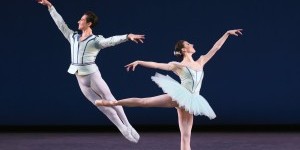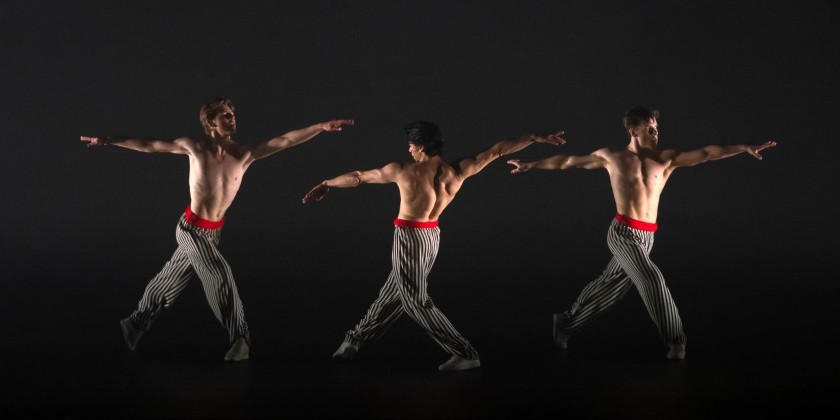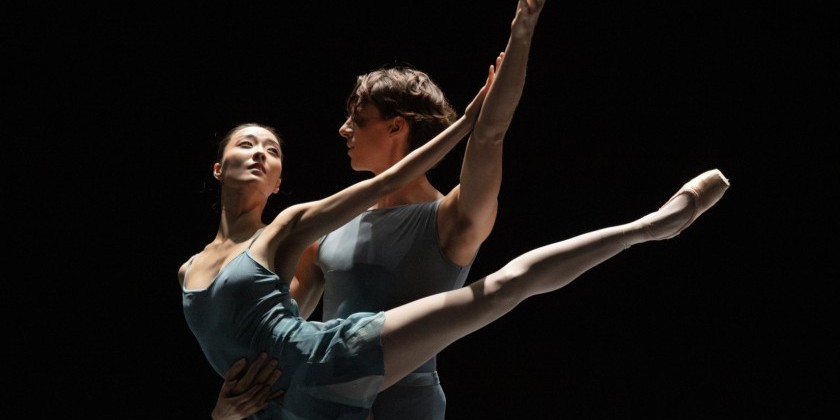IMPRESSIONS: Dance Theatre of Harlem at New York City Center

Dance Theatre of Harlem
Founders: Arthur Mitchell and Karel Shook
Artistic director: Robert Garland
Executive director: Anna Glass
Rehearsal director: Juan Carlos Peñuela
Dance artists: Ariana Dickerson, Lindsey Donnell, Carly Greene, Alexandra Hutchinson, Alexandra Rene Jones, Kira Robinson, Kamala Saara, Crystal Serrano, Ingrid Silva, Delaney Washington, Stephanie Rae Williams, Derek Brockington, Micah Bullard, Julian Cottrell, Kouadio Davis, Keenan English, Elias Re, Luis Fernando Rego, Ethan Wilson, and David Wright
In recent years, Dance Theatre of Harlem has tended to ignore the “theatre” in its name. The dancers are engaging and expressive, yet the elaborate production values once associated with this company remained a memory on the opening night of its New York City Center season on April 10, 2025. Director Robert Garland seemed determined to prove that slick abstractions could supply all the drama a viewer might want.

The company presented four ballets by as many choreographers; and each bore an authorial stamp. There is no confusing Jodie Gates’ lush new ballet Passage of Being with William Forsythe’s hectic Vertiginous Thrill of Exactitude, or with the sly wit of George Balanchine’s Donizetti Variations. Garland’s season premiere, The Cookout, typically comes peppered with references to Black culture, particularly the playful social greeting known as "the dap."
Even so, despite the ballets’ distinct profiles, and their shifts in mood, music, and lighting, this year’s opening program relies for scenery on the audience’s imagination and expects us to bring an insatiable appetite for steps.

Garland also relies on program notes to explain The Cookout, whose subtext might otherwise pass unnoticed in this breezy dance set to a funk-soul medley. Thus, we learn that Micah Bullard’s duet with a broom, his hips pulsing to the rhythm as he sweeps the stage, affirms the dignity of work. An episode in which dancers greet each other swiping hands and bumping chests (the “dap”) represents the dignity of culture; while another scene in which women seem to push away unwanted thoughts and fold in pain, represents the dignity of grief. Briefly dancers appear silhouetted against a sorrowful blue background. Yet the choreography seems too slight to bear the burden of significance. Garland is on safer ground depicting joy in the concluding party scene.

In part two, Kouadio Davis attracts attention casually flexing his bicep and tossing off multiple pirouettes; and when he returns in the finale it’s clear this Cookout is his party. As the curtain descends, Davis playfully drops to the floor to steal a few more seconds in the limelight.

While The Cookout displays the dancers’ svelte lines in a casual way, The Vertiginous Thrill of Exactitude creates a sense of urgency with its darting, restless symmetries and risky dislocations. We still see filigreed pas de bourrées; and the women tilt their heads and gesture courteously. Yet this ballet demands breathless speed; and the women’s legs, bared to the hips under rubbery, disc-shaped tutus, strike out with lethal force. Doubling the number of women in the cast, from three to six, gives DTH a bespoke version of this 1996 classic, but the women’s heroism feels diminished in an ensemble.

The mood changes drastically in Gates’ premiere, Passage of Being, an evocation of life’s transience that passes from wistfulness to emotional angst. The cast assembles in a twilit meeting ground, where Alexandra Rene Jones becomes the sprightly focus of the men’s attentions. Partnerships will be the focus of this dance. As the men take turns dipping, sliding, and carrying Jones, their momentum suggests the “passage” of the title. The dancers seem to fly or skim above the floor, their swiftness amplified by the fluttering of light-weight costumes.

Physically challenging and expressive, Passage of Being manages to be showy, despite the dappled lighting and a moody, electronic score by Ryan Lott and his band, Son Lux. Kamala Saara and Derek Brockington are the principal couple, their recurring duet featuring spectacular lifts, with the ballerina thrown over his shoulder or launched into space only to return and wind herself around his body. At the end, however, Saara finds herself without a partner, flinging herself into space and breathing hoarsely while the others gather upstage behind her. The music has stopped; and Saara’s only companions appear to be memories.

Though Passage of Being makes a solid addition to DTH’s repertoire, nothing on this program has the sheer pizzazz of George Balanchine's Donizetti Variations (1960), staged by Kyra Nichols. Good old “Mr. B!” Though ostensibly an old-fashioned romp, this ballet gives us so much to admire. For one thing, the choreography displays a masterful economy, particularly in the handling of the ensemble, with three trios each made up of a man and two women. These individuals shift position moving around one another in close proximity, or spread out as needed to create kaleidoscopic patterns. Space is at a premium onstage, but Balanchine knows how to scrimp, and when to be generous.
Though classical ballet and modern dance are not supposed to fraternize, and no one speaks of Balanchine in the same breath as his contemporary colleagues, it may be interesting to speculate on the example Balanchine’s thrifty use of space set for choreographers who, in their turn, would tackle the challenge of moving dancers around in tight places. We may think of both Paul Taylor (Mercuric Tidings,1982) and Trisha Brown (Set and Reset, 1983) in this regard.

Balanchine, of course, was also a 20th-century modernist, whose most traditional works can be seen as concessions to popular taste. Gaetano Donizetti's bel canto melodies surely seemed quaint to Balanchine, after having worked with Igor Stravinsky. Thus, with a wink to the present day, Donizetti Variations briefly satirizes its roots in operatic melodrama. The ensemble members turn to shield their eyes in horror, giving an over-ambitious coryphée the opportunity to break ranks and perform a quick solo when no one is looking. Stubbing her toe, she returns despondently to her place in line.
This gag may be seen as a half-hearted apology not only for the choice of music, but also for the grand-standing of the ballet’s principal couple, who are stars in that good-old ballet way that knocks out the viewer’s head-lights. Yet Balanchine isn’t sorry. He seems to enjoy the barnstorming more than anyone, coming up with new “tricks” to wow the crowd — like the series of little air-turns that the ballerina performs in her partner’s hands, landing neatly on her pointes. Thanks to Balanchine’s economy, all the steps seem to have air around them, so that despite interweaving and the inevitable farandole, the footwork possesses astonishing clarity; and each ensemble member stands out.

DTH’s current cast had not been born when the company’s visionary founder, Arthur Mitchell, learned the fine points of Balanchine’s style from the choreographer himself. Yet dancing Donizetti Variations, these youngsters seem perfectly at home. In the ballerina role, Alexandra Hutchinson sparkles with elegance achieving the right balance between daring and nonchalance. Her partner, David Wright, gets off to a rocky start, but redeems himself with a sequence of stunning pirouettes. Each member of the ensemble fascinates, but Lindsey Donnell seems especially neat.
Dance Theatre of Harlem has never depended upon Balanchine for its repertoire, or its reputation, but clearly it is a good idea to keep this choreographer’s works in the mix.














